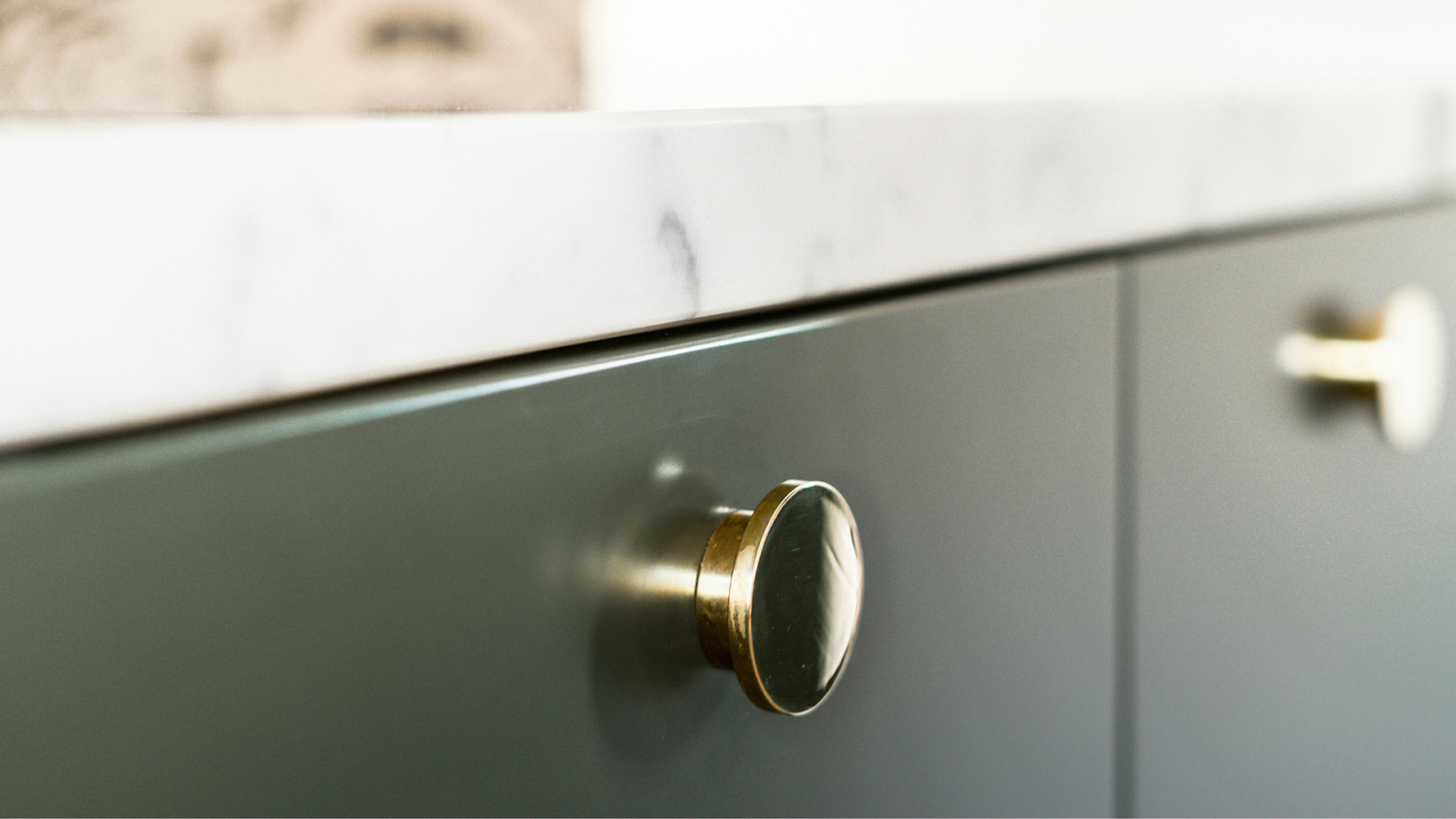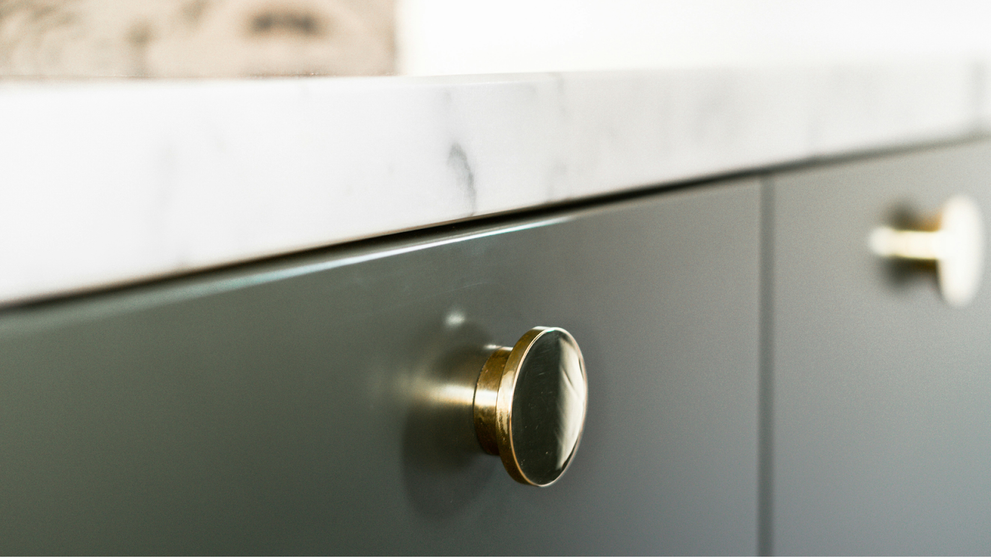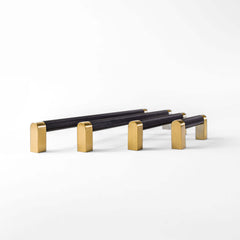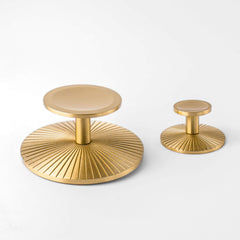Key Takeaways:
- Why Aged Brass Speaks To Designers: Aged brass offers warmth, richness, and personality that polished finishes can’t replicate. Its patina tells a story through softened edges and subtle tone shifts, adding depth to traditional interiors and anchoring modern spaces.
- How To Speed Up Brass Oxidation: Household ingredients like vinegar, salt, ammonia, and even boiled eggs can accelerate patina on genuine brass. These approachable methods let you explore how to age brass quickly while still creating layered, character-filled finishes.
- What To Do After Aging Brass: After aging, brass can be left raw to continue evolving or sealed with wax, oil, or lacquer to preserve the tone. Each finishing option shapes how the hardware lives in your space.
Step into a space suffused with stories and rich in the magic of time-worn detail. There’s something irresistible about the way aged brass glows, a warmth that feels both storied and alive, as if every scuff and patinaed edge has a tale to tell. At Inspire Hardware, our journey began with an infatuation for textures that invite a second glance and finishes that feel lovingly chosen. We believe the hardware you touch every day should go beyond mere function.
But what if the natural luster of brass is just a bit too new, too polished, whispering of a showroom more than your sanctuary? Embracing aged brass is about honoring the character that only time can bestow. In this guide, we’ll discuss approachable ways to coax out that lived-in warmth from contemporary pieces. Discover how a bit of hands-on artistry, paired with patience and a love for evocative design, can turn hardware into heirlooms.
Why Aged Brass Speaks to Designers and Dreamers
Aged brass holds a tactile kind of poetry. What begins as a polished surface evolves into something deeper, richer, and more storied, shaped by time and light, not trends. For those curating interiors with meaning and character, aged brass offers more than a surface sheen. Let’s explore why aged brass has caught the attention of designers.
Style with Substance: Why Patina Draws the Eye
Fresh brass has its place, but it often reads as too bright, too untouched. Aged brass, on the other hand, brings quiet drama and a lived-in elegance. From soft gold to moody bronze, the metal’s natural hue creates visual texture that blends beautifully with historic interiors. In a Victorian-inspired reading nook, a solid brass door knob dulled by age feels as if it has always belonged there. On the doors of a high-ceilinged hallway with herringbone floors, that softened glow adds rhythm and richness, catching daylight in subtle, surprising ways.
Personality in the Details: How Aged Brass Grounds a Room
Vintage interiors tell layered stories, and aged brass fits right in. A set of Demi Lune brass door handles, for example, takes on extra dimension when the finish feels worn by decades of use, even if they were just installed. In kitchens styled with shaker cabinetry and soapstone counters, a softly patinated pull lends a grounding touch. Even in a French country-inspired bedroom, an aged brass knob on a closet door brings a hint of refinement that doesn’t try too hard.
More Than a Finish: Aged Brass as Atmosphere
Brass that’s allowed to age gracefully feels personal. It responds to its environment, absorbing warmth from touch and deepening in tone as seasons pass. In homes where every element matters, aged brass becomes a connector that ties together the old and the new, the collected and the clean-lined. Whether anchoring a mudroom bench with pieces from our modern solid brass hardware or bringing softness to painted cabinetry featured in our cabinet styles guide, aged brass doesn’t fade into the background.
How to Tell If Your Brass Is the Real Deal
Before you can begin transforming hardware with a vintage patina, you need to know exactly what you’re working with. Solid brass and plated metals may look strikingly similar at first glance, but their composition are worlds apart. Use these tips to confidently spot the real deal:
- Feel the weight: Solid brass has a satisfying heft. Plated hardware often feels lighter and more hollow, a sign of lower-cost core materials like zinc or aluminum.
- Scratch beneath the surface: In a hidden area, use a pin or blade to lightly scratch the surface. Solid brass reveals the same warm golden tone throughout, while plated pieces expose a dull gray or silver base beneath the coating.
- Check the finish at wear points: Over time, the edges of brass-plated items tend to chip or flake, revealing their true base metal. Look around screw holes or corners; if you see inconsistent coloring, you're likely working with a thin layer of brass.
- Try the magnet test: Brass doesn’t react to magnets. If one sticks to your hardware, there’s iron or steel beneath the surface. Solid brass, including pieces from our solid brass door knobs collection, will remain unaffected.
- Observe how it ages: Patina forms differently on real brass. With time, solid brass develops a mellow, lived-in luster. Plated or brushed finishes often fade unevenly or develop a spotty look when exposed to air, moisture, or cleaning products. When aiming for a natural patina, start with real, unlacquered brass, like pieces found in our Solid Brass Hardware collection.
How to Speed Up Brass Oxidation Naturally
Sometimes, the clean gleam of new brass doesn’t match the mood of your space. Fortunately, homeowners and designers can gently accelerate oxidation using ingredients already in the pantry. For starters, make sure your hardware is unlacquered and clean. Use warm soapy water and a soft cloth to remove oils or polish. If needed, dab a bit of acetone or nail polish remover in a discreet spot to strip away stubborn coatings.
Vinegar and Salt: The Classic Kitchen Alchemy
This pairing is the go-to for gently coaxing out brass’s natural glow. The acidity in white vinegar reacts with the copper content in solid brass, while salt helps agitate the surface. Mix equal parts vinegar and salt into a grainy paste, then rub it across the hardware in small circles. Let it rest for up to an hour, rinse thoroughly, and pat dry. The results often include soft golden mottling with hints of warmth, far richer than anything a brushed surface can mimic.
Ammonia Fuming: Fast, Bold, and Beautiful
For a more dramatic transformation, ammonia speeds oxidation quickly. Place your brass piece on a small rack inside a sealed container and add a shallow dish of household ammonia at the bottom. The metal should remain above the liquid to avoid saturation. As fumes rise, they react with the brass’s surface, deepening the color and adding moody, expressive tones. This method works best with solid brass hardware, where the reaction continues across the entire surface and not just a fragile top layer.
Egg Patina: A Subtle, Sulfur-Rich Finish
Yes, an egg. When sealed with warm, peeled hard-boiled eggs in a container or bag, real brass absorbs the sulfuric gases released naturally. This slow, gentle process results in dusky browns and smoky golds that resemble years of natural oxidation. Unlike plated items, genuine brass will react evenly and hold onto these tones without flaking or fading.
How to Rinse and Dry Aged Brass for a Beautiful, Streak-Free Finish
Once your hardware has reached that just-right vintage tone, the final steps are all about care and attention. These finishing touches help preserve the patina while letting your brass continue to age gracefully in your space. Here’s how to clean and dry your pieces with intention:
- Rinse gently with cool water: Use a soft stream to flush away the aging solution. Let water move across every ridge and groove to clear out any leftover salt, vinegar, or ammonia. For pieces like solid brass door knobs, pay special attention to recessed areas, where residue tends to settle.
- Avoid scrubbing or polishing: At this stage, friction can mar the patina you’ve created. Skip the sponge and stick to a soft rinse. The goal is to retain the finish’s subtle texture, not buff it away.
- Prepare a neutralizing bath: Fill a bowl or container with water and add a few spoonfuls of baking soda. Swirl your brass piece gently in the mix. This reaction helps stop oxidation in its tracks, stabilizing the surface so your new look stays consistent.
- Pat dry with a lint-free cloth: Instead of rubbing, blot the hardware. This gentle pressure absorbs moisture without streaks or smudges. Linen or microfiber works best to preserve the integrity of the patina.
- Let it air dry fully: Rest your brass on a clean, dry surface and let the air do the rest. A simple breeze helps reveal the finish in its full richness. This is the moment your piece settles into its new personality, perfect for statement fixtures.
What to Do After Aging Brass: Seal It or Let It Evolve?
After learning how to age brass quickly with kitchen staples or gentle oxidation techniques, you may wonder how to preserve the look or whether to let it shift even more over time. Both paths are valid, and each finish brings a unique mood to your space. Here's how to decide:
- Leave the brass raw and let it deepen naturally: Unsealed brass tells a slow-burning story. As it interacts with air, moisture, and touch, it darkens and softens in a way that feels personal and lived-in. This approach works beautifully in kitchens, studies, and entryways where transformation becomes part of the design. For examples of where raw finishes shine, browse our solid brass door knobs collection.
- Seal with microcrystalline wax for a low-luster sheen: Wax helps maintain the aged appearance while offering a subtle protective layer. It’s a gentle way to minimize fingerprints and tarnish on high-touch surfaces without losing character. For homeowners refining their cabinetry, this option pairs beautifully with styles from our cabinet styles guide.
- Use tung oil or linseed oil to enrich the color: Natural oils can deepen brass’s hue while giving it a smooth, touchable finish. On modern solid brass hardware, this technique adds warmth and a slight amber tint that plays well with wood textures and vintage lighting. It doesn’t freeze the finish in place, but it slows oxidation gracefully.
- Apply clear lacquer for full preservation: Lacquer locks in the finish. While it halts further patina development, it also provides a smooth, easy-to-clean surface with lasting shine. This route works well for those who’ve figured out how to age polished brass to just the right tone and want to keep that moment intact. For tips on long-term care, visit our guide to care for antique and satin brass finishes.
Final Thoughts
There’s a quiet magic in the subtle patina of aged brass. Each softened edge and muted shimmer tells a story of time, touch, and the everyday rituals that transform a house into a home. Learning how to age brass invites you to craft an experience. You're drawing out the soulful warmth and nuanced character buried within the metal, encouraging it to interact with light, shadow, and memory in a way only vintage brass can.
Whether you're experimenting with how to age brass quickly for a fast transformation or exploring how to age polished brass with care, each method allows your hardware to evolve with intention. At Inspire Hardware, our passion lies in celebrating these textures and tones, lifting them beyond function into something expressive and lasting. For tips on maintaining that character over time, visit our guide to care for antique and satin brass finishes.
Read more:
- A Step-by-Step Guide to Painting Kitchen Cabinets Like a Pro
- The Different Types Of Cabinet Hinges And How They Work
- Modern Kitchen Ideas: 10 Cabinet Designs for a Fresh Look
Frequently Asked Questions About How to Age Brass Naturally
Can household items age brass?
Absolutely. Household staples like vinegar, salt, lemon juice, and ammonia can accelerate oxidation on solid brass, revealing a rich, timeworn patina. These approachable materials make aging accessible to design professionals and creative homeowners without needing specialty chemicals. You’ll find several of these methods on how to age brass quickly.
Can I age lacquered brass myself?
Yes, but there’s an extra step. Lacquer forms a barrier that blocks moisture and air from reaching the metal underneath. To age lacquered pieces, gently remove the coating with lacquer remover or fine steel wool. Test in a discreet spot first, then clean thoroughly before applying any patina treatment.
Can sandpaper help age brass?
In small doses, yes. A fine-grit sandpaper can help scuff away excess shine or lacquer, exposing raw brass beneath. Subtle pressure is key, as too much abrasion can cause patchiness rather than the natural, layered look you're aiming for.
How can I maintain aged brass?
Aged brass is a living finish, so treat it gently. Aged brass is a responsive surface that evolves. Dust with a soft cloth, and when needed, use a dab of neutral wax to protect without erasing character. For long-term care tips, visit our guide to care for antique and satin brass finishes.
Should I seal brass after aging?
That depends on your vision. Sealing with wax or matte lacquer can preserve the exact finish you’ve achieved. Leaving brass raw allows it to shift naturally with use and time. Both options are valid. It comes down to whether you want a living finish or a paused moment of vintage beauty.
Will aging brass affect its overall value?
Thoughtfully aged brass often carries more appeal than factory-polished alternatives. For example, a soft, storied patina adds visual interest and authenticity, particularly when applied to high-quality hardware. Many design-minded homeowners view it as a finish that elevates the overall space.
How can I prevent over-aging brass?
Move slowly. Patina develops in subtle layers, and each step adds to the final tone. Rinse and dry between applications, and pause when the brass reaches a tone that feels timeless. For anyone learning how to age polished brass, patience will always produce a more beautiful finish.







